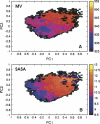Structure of the 21-30 fragment of amyloid beta-protein
- PMID: 16731963
- PMCID: PMC2265091
- DOI: 10.1110/ps.062076806
Structure of the 21-30 fragment of amyloid beta-protein
Abstract
Folding and self-assembly of the 42-residue amyloid beta-protein (Abeta) are linked to Alzheimer's disease (AD). The 21-30 region of Abeta, Abeta(21-30), is resistant to proteolysis and is believed to nucleate the folding of full-length Abeta. The conformational space accessible to the Abeta(21-30) peptide is investigated by using replica exchange molecular dynamics simulations in explicit solvent. Conformations belonging to the global free energy minimum (the "native" state) from simulation are in good agreement with reported NMR structures. These conformations possess a bend motif spanning the central residues V24-K28. This bend is stabilized by a network of hydrogen bonds involving the side chain of residue D23 and the amide hydrogens of adjacent residues G25, S26, N27, and K28, as well as by a salt bridge formed between side chains of K28 and E22. The non-native states of this peptide are compact and retain a native-like bend topology. The persistence of structure in the denatured state may account for the resistance of this peptide to protease degradation and aggregation, even at elevated temperatures.
Figures






Similar articles
-
Aβ monomers transiently sample oligomer and fibril-like configurations: ensemble characterization using a combined MD/NMR approach.J Mol Biol. 2013 Sep 23;425(18):3338-59. doi: 10.1016/j.jmb.2013.06.021. Epub 2013 Jun 25. J Mol Biol. 2013. PMID: 23811057 Free PMC article.
-
Influence of preformed Asp23-Lys28 salt bridge on the conformational fluctuations of monomers and dimers of Abeta peptides with implications for rates of fibril formation.J Phys Chem B. 2009 Jan 29;113(4):1162-72. doi: 10.1021/jp808914c. J Phys Chem B. 2009. PMID: 19125574 Free PMC article.
-
Structures and free-energy landscapes of the wild type and mutants of the Abeta(21-30) peptide are determined by an interplay between intrapeptide electrostatic and hydrophobic interactions.J Mol Biol. 2008 Jun 13;379(4):815-29. doi: 10.1016/j.jmb.2008.04.028. Epub 2008 May 14. J Mol Biol. 2008. PMID: 18479708 Free PMC article.
-
Understanding amyloid fibril nucleation and aβ oligomer/drug interactions from computer simulations.Acc Chem Res. 2014 Feb 18;47(2):603-11. doi: 10.1021/ar4002075. Epub 2013 Dec 24. Acc Chem Res. 2014. PMID: 24368046 Review.
-
The Structure-Activity Relationship of Glycosaminoglycans and Their Analogues with β-Amyloid Peptide.Protein Pept Lett. 2016;23(4):358-64. doi: 10.2174/0929866523666160115131517. Protein Pept Lett. 2016. PMID: 26767428 Review.
Cited by
-
Investigating how peptide length and a pathogenic mutation modify the structural ensemble of amyloid beta monomer.Biophys J. 2012 Jan 18;102(2):315-24. doi: 10.1016/j.bpj.2011.12.002. Biophys J. 2012. PMID: 22339868 Free PMC article.
-
Identification of key regions and residues controlling Aβ folding and assembly.Sci Rep. 2017 Oct 3;7(1):12434. doi: 10.1038/s41598-017-10845-6. Sci Rep. 2017. PMID: 28974765 Free PMC article.
-
Interaction of amyloid beta with humanin and acetylcholinesterase is modulated by ATP.FEBS Open Bio. 2020 Dec;10(12):2805-2823. doi: 10.1002/2211-5463.13023. Epub 2020 Nov 18. FEBS Open Bio. 2020. PMID: 33145964 Free PMC article.
-
β-amyloid model core peptides: Effects of hydrophobes and disulfides.Protein Sci. 2020 Feb;29(2):527-541. doi: 10.1002/pro.3778. Epub 2019 Nov 25. Protein Sci. 2020. PMID: 31710741 Free PMC article.
-
Ion Mobility Mass Spectrometry (IM-MS) for Structural Biology: Insights Gained by Measuring Mass, Charge, and Collision Cross Section.Chem Rev. 2023 Mar 22;123(6):2902-2949. doi: 10.1021/acs.chemrev.2c00600. Epub 2023 Feb 24. Chem Rev. 2023. PMID: 36827511 Free PMC article. Review.
References
-
- Antzutkin O.N., Leapman R.D., Balbach J.J., Tycko R. 2002. Supramolecular structural constraints on Alzheimer's β-amyloid fibrils from electron microscopy and solid-state nuclear magnetic resonance Biochemistry 41 15436–15450. - PubMed
-
- Berendsen H.J.C., van der Spoel D., van Drunen R. 1995. GROMACS: A message-passing parallel molecular dynamics implementation Comput. Phys. Commun. 91 43–56.
-
- Chimon S. and Ishii Y. 2005. Capturing intermediate structures of Alzheimer's β-amyloid, Aβ (1-40), by solid-state NMR spectroscopy J. Am. Chem. Soc. 127 13472–13473. - PubMed
Publication types
MeSH terms
Substances
Grants and funding
LinkOut - more resources
Full Text Sources
Other Literature Sources

